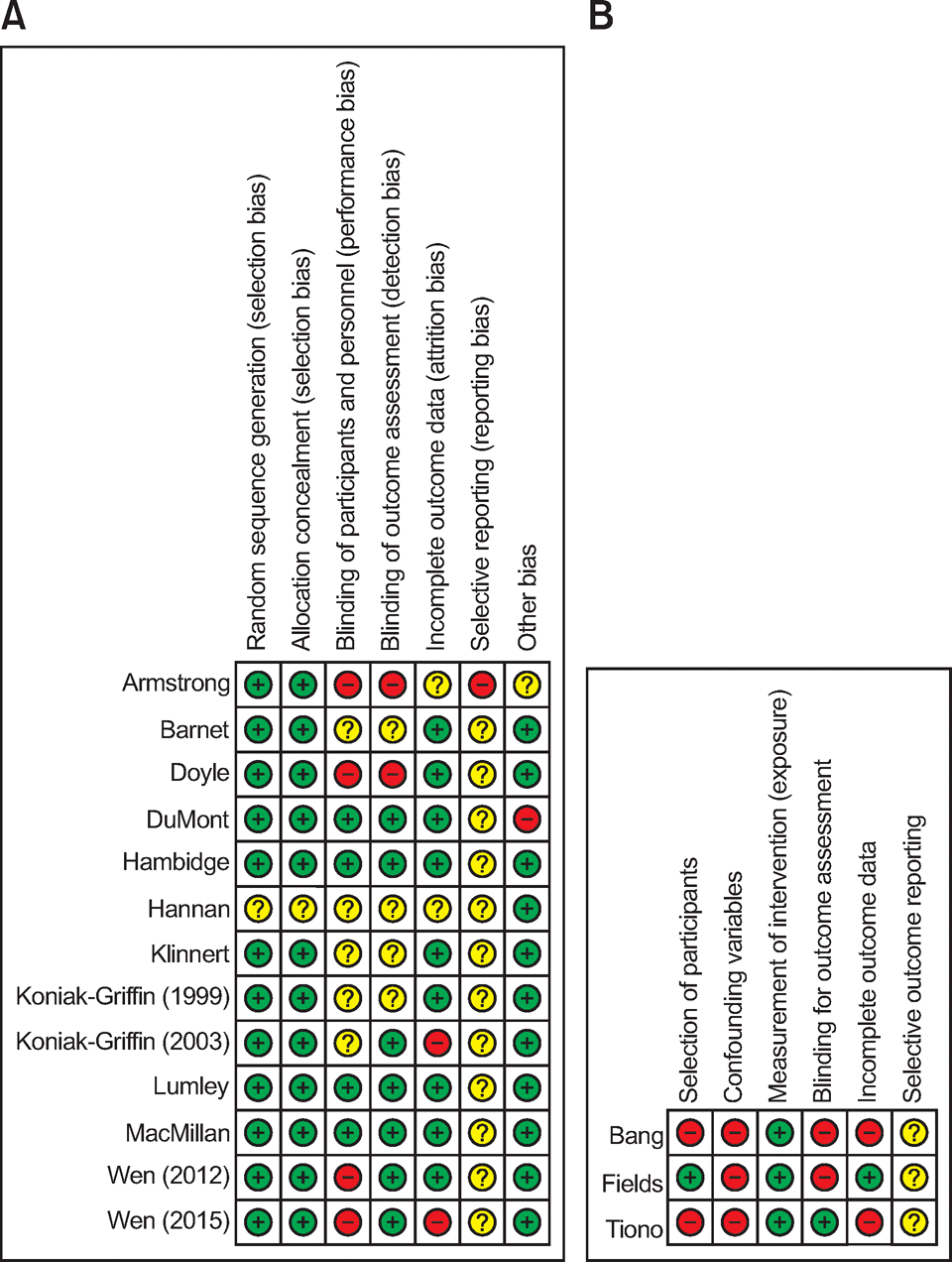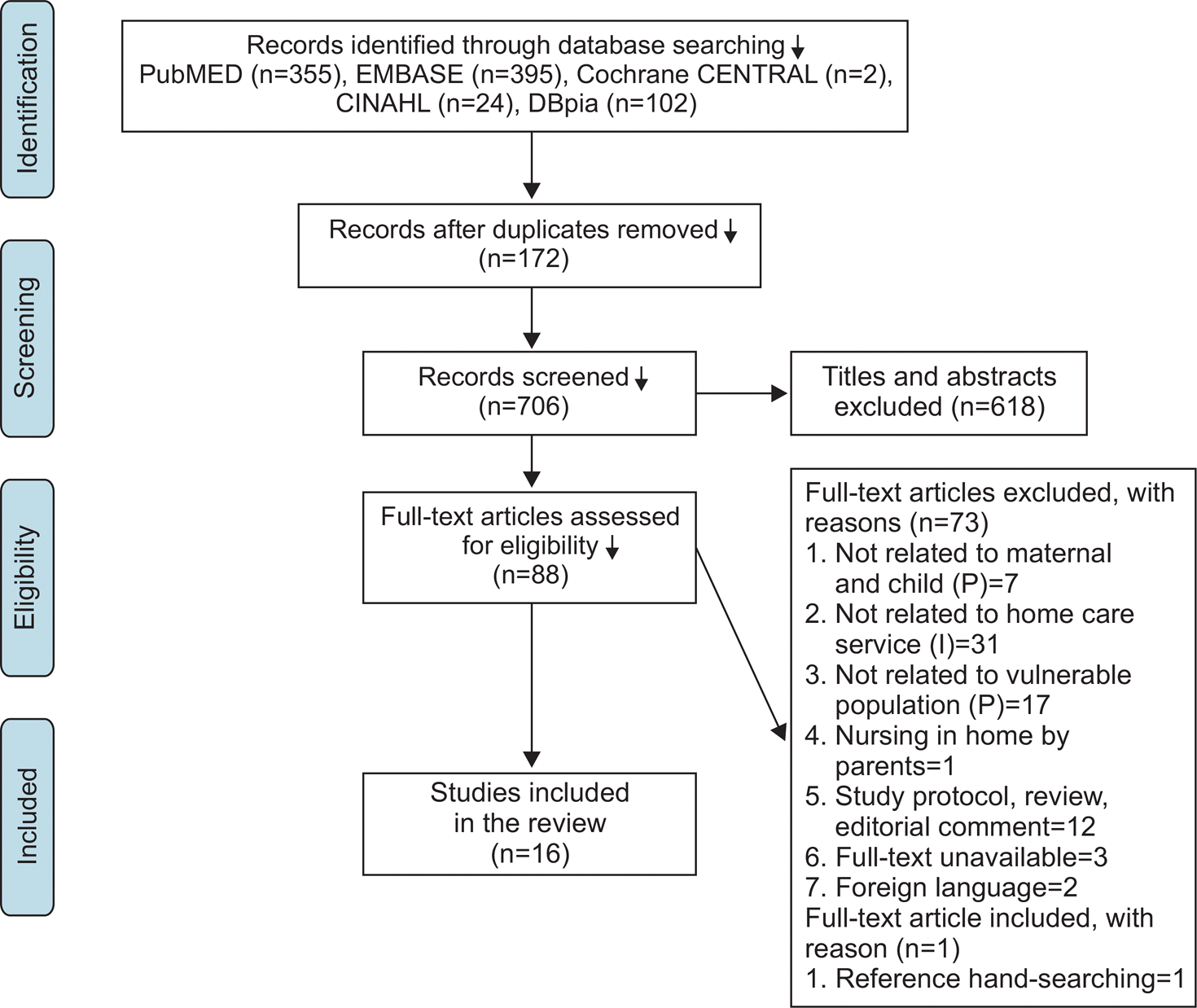Abstract
Purpose
This study was intended to integrate the evidence of home care service intervention for mothers and children in vulnerable groups through an integrative literature review.
Methods
We searched the MEDLINE (PubMED), EMBASE, Cochrane Central Register of Controlled Trials, CINAHL, DBpia databases. The quality of the articles was assessed by one doctoral researcher and verified by one professor of community health nursing who had participated in the systematic review of literature. A framework was developed to identify the intervention patterns in the selected papers and categorize various elements. The extracted intervention elements were grouped into potential themes, which were verified by assessors on whether they clearly reflected the interventions in the papers.
Results
Among 878 searched papers, we selected 16 papers after excluding literature that does not satisfy the selection criteria and quality evaluation. The intervention elements of 16 selected papers were categorized into six themes. The extracted intervention elements were divided into the themes of Patient-specific/Situation-specific care planning and intervention, Emphasis on self care competency, Intense home visit by developmental milestone, Reinforcing and modeling mother-child attachment, Communication and interaction across the intervention, Linkage with community resource and multidisciplinary approach.
Conclusion
As a result of the analysis of proper interventions of home care services for mothers and children in vulnerable groups, it was found that it is necessary to consider indispensable intervention elements that can standardize the quality of home care services, and conduct studies on developing intervention programs based on the elements.
References
1. Macintyre S. The black report and beyond: What are the issues? Social Science & Medicine. 1997; 44(6):723–745. https://doi.org/10.1016/S0277-9536(96)00183-9.

2. Evans T, Whitehead M, Diderichsen F, Bhuiya A, Wirth M. Challenging inequities in health: From ethics to action [Internet]. New York: Oxford University Press;c2001. [cited 2017 Jan 30]. Available from. https://books.google.co.kr/books/about/Challeng-ing_Inequities_in_Health.html?id=VpUiV5k0EAUC&source=kp_cover&redir_esc=y.
3. Dobson SM. Conceptualizing for transcultural health visiting: The concept of transcultural reciprocity. Journal of Advanced Nursing. 1989; 14(2):97–102. https://doi.org/10.1111/j.1365-2648.1989.tb00906.x.

4. Health Resource & Services Administration, Maternal & Child Health (US). Home visiting [Internet]. U.S.: Health Resource & Services Administration (HRSA);c2016. [cited 2016 Dec 27]. Available from. https://mchb.hrsa.gov/maternal-child-health-initiatives/home-visiting-overview.
5. Kang YS, Kwon IS. Health status of vulnerable preschool children and their mothers’ health management. Child Health Nursing Research. 2013; 19(3):159–167.

6. Kim E, Lee J. Study on current policies and desirable policy directions of child raising support benefits for disadvantages families: Focusing on poor, single parent, and disabled families. Social Welfare Policy. 2006; 25:253–278.
7. Whittemore R, Knafl K. The integrative review: Updated methodology. Journal of Advanced Nursing. 2005; 52(5):546–553. https://doi.org/10.1111/j.1365-2648.2005.03621.x.

8. Flaskerud JH, Winslow BJ. Conceptualizing vulnerable populations health-related research. Nursing Research. 1998; 47(2):69–78.

9. Higgins JPT, Green S. Cochrane handbook for systematic reviews of interventions version 5.1.0 [Internet]. London: The Cochrane Collaboration;c2011. [cited 2016 Dec 27]. Available from. http://training.cochrane.org/handbook.
10. Kim SY, Park JE, Seo HJ, Lee YJ, Jang BH, Son HJ, et al. NECA’s guidance for undertaking systematic reviews and meta-analyses for intervention. Seoul: National Evidence-based Healthcare Collaborating Agency;2011. p. 86–91.
11. Kirkevold M. Integrative nursing research: An important strategy to further the development of nursing science and nursing practice. Journal of Advanced Nursing. 1997; 25(5):977–984. https://doi.org/10.1046/j.1365-2648.1997.1997025977.x.
12. Seo HJ, Kim SY, Lee YJ, Jang BH, Park JE, Sheen SS, et al. A newly developed tool for classifying study designs in systematic reviews of interventions and exposures showed substantial reliability and validity. Journal of Clinical Epidemiology. 2016; 70:200–205. https://doi.org/10.1016/j.jclinepi.2015.09.013.

13. Braun V, Clarke V. Using thematic analysis in psychology. Qualitative Research in Psychology. 2006; 3(2):77–101. https://doi.org/10.1191/1478088706qp063oa.

14. Lumley J, Donohue L. Aiming to increase birth weight: A randomised trial of pre-pregnancy information, advice and counselling in inner-urban Melbourne. BMC Public Health. 2006; 6:299. https://doi.org/10.1186/1471-2458-6-299.

15. Hannan J. APN telephone follow up to low-income first time mothers. Journal of Clinical Nursing. 2013; 22(1-2):262–270. https://doi.org/10.1111/j.1365-2702.2011.04065.x.

16. Klinnert MD, Liu AH, Pearson MR, Tong S, Strand M, Luck-ow A, et al. Outcome of a randomized multifaceted intervention with low-income families of wheezing infants. Archives of Pediatrics & Adolescent Medicine. 2007; 161(8):783–790. https://doi.org/10.1001/archpedi.161.8.783.

17. MacMillan HL, Thomas BH, Jamieson E, Walsh CA, Boyle MH, Shannon HS, et al. Effectiveness of home visitation by public-health nurses in prevention of the recurrence of child physical abuse and neglect: A randomised controlled trial. Lancet. 2005; 365(9473):1786–1793. https://doi.org/10.1016/S0140-6736(05)66388-X.

18. Koniak-Griffin D, Mathenge C, Anderson NLR, Verzemnieks I. An early intervention program for adolescent mothers: A nursing demonstration project. Journal of Obstetric, Gynecologic, & Neonatal Nursing. 1999; 28(1):51–59. https://doi.org/10.1111/j.1552-6909.1999.tb01964.x.

19. Koniak-Griffin D, Verzemnieks IL, Anderson NL, Brecht ML, Lesser J, Kim S, et al. Nurse visitation for adolescent mothers: two-year infant health and maternal outcomes. Nursing Research. 2003; 52(2):127–136.
20. DuMont K, Mitchell-Herzfeld S, Greene R, Lee E, Lowenfels A, Rodriguez M, et al. Healthy Families New York (HFNY) randomized trial: Effects on early child abuse and neglect. Child Abuse & Neglect. 2008; 32(3):295–315. https://doi.org/10.1016/j.chiabu.2007.07.007.

21. Armstrong KL, Fraser JA, Dadds MR, Morris J. Promoting secure attachment, maternal mood and child health in a vulnerable population: A randomized controlled trial. Journal of Paediatrics and Child Health. 2000; 36(6):555–562. https://doi.org/10.1046/j.1440-1754.2000.00591.x.

22. Doyle O, McGlanaghy E, Palamaro-Munsell E, McAuliffe FM. Home based educational intervention to improve perinatal outcomes for a disadvantaged community: A randomised control trial. European Journal of Obstetrics & Gynecology and Reproductive Biology. 2014; 180:162–167. https://doi.org/10.1016/j.ejogrb.2014.06.006.

23. Fields ME, Abel R, Vesely SK, Drazen CH, King A. A pilot study of parent education intervention improves early childhood development among toddlers with sickle cell disease. Blood. 2015; 126(23):527.

24. Tiono AB, Kaboré Y, Traoré A, Convelbo N, Pagnoni F, Sirima SB. Implementation of Home based management of malaria in children reduces the work load for peripheral health facilities in a rural district of Burkina Faso. Malaria Journal. 2008; 7:201. https://doi.org/10.1186/1475-2875-7-201.

25. Wen LM, Baur LA, Simpson JM, Rissel C, Wardle K, Flood VM. Effectiveness of home based early intervention on children’s BMI at age 2: Randomised controlled trial. BMJ. 2012; 344:e3732. https://doi.org/10.1136/bmj.e3732.

26. Wen LM, Baur LA, Simpson JM, Xu H, Hayes AJ, Hardy LL, et al. Sustainability of effects of an early childhood obesity prevention trial over time: A further 3-year follow-up of the healthy beginnings trial. JAMA Pediatrics. 2015; 169(6):543–551. https://doi.org/10.1001/jamapediatrics.2015.0258.
27. Barnet B, Liu J, DeVoe M, Duggan AK, Gold MA, Pecukonis E. Motivational intervention to reduce rapid subsequent births to adolescent mothers: A community-based randomized trial. Annals of Family Medicine. 2009; 7(5):436–445. https://doi.org/10.1370/afm.1014.

28. Hambidge SJ, Phibbs SL, Chandramouli V, Fairclough D, Steiner JF. A stepped intervention increases well-child care and immunization rates in a disadvantaged population. Pediatrics. 2009; 124(2):455–464. https://doi.org/10.1542/peds.2008-0446.

29. Bang KS. Effects of an early nursing intervention program for infants’ development and mother’s child rearing in poverty. Journal of Korean Academy of Nursing. 2009; 39(6):796–804. https://doi.org/10.4040/jkan.2009.39.6.796.

30. Dunst CJ, Johanson C, Trivette CM, Hamby D. Family-oriented early intervention policies and practices: Family-centered or not? Exceptional Children. 1991; 58(2):115–126. https://doi.org/10.1177/001440299105800203.

31. National Research Council. A study of interactions: Emerging issues in the science of adolescence: Workshop summary. Washington, D.C: National Academies Press;2006. p. 8–9.
Figure 1.
Quality assessment of selected studies. (A) Risk of bias for randomized controlled trials (RoB). (B) Risk of bias for non-randomized studies (RoBANS)

Table 1.
Analysis of Home Care Services of Relevant Research
Table 2.
Characteristics of Relevant Studies and Interventions (N=16)




 PDF
PDF ePub
ePub Citation
Citation Print
Print



 XML Download
XML Download